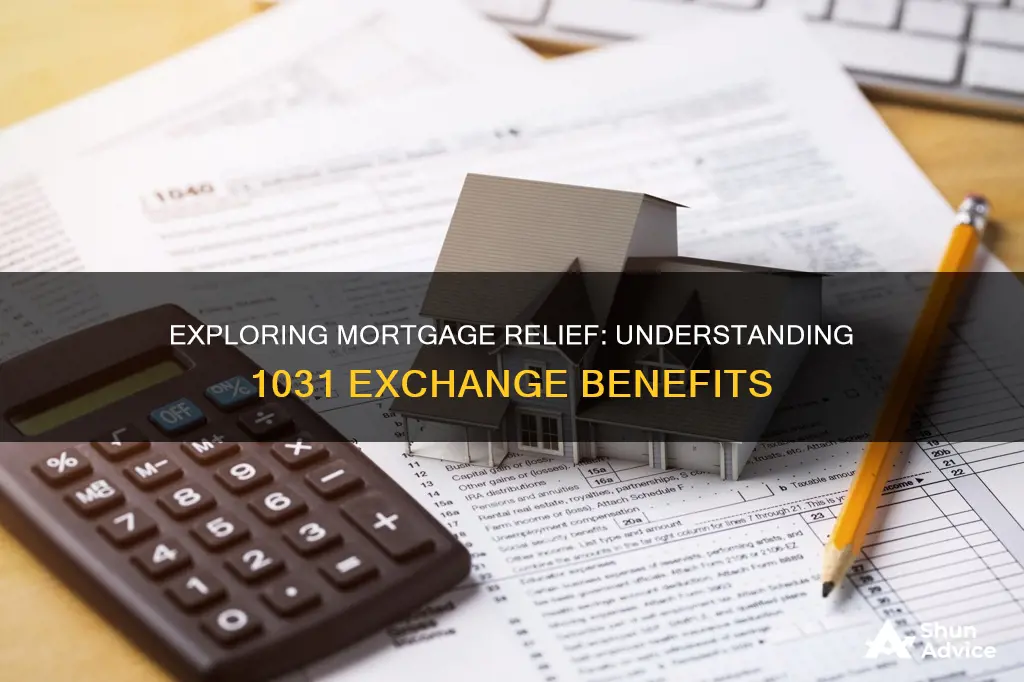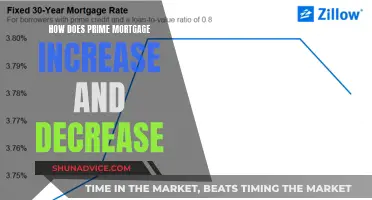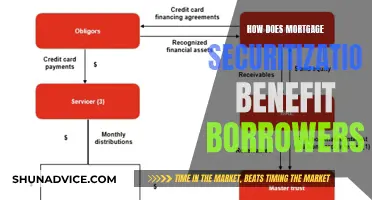
A 1031 exchange, also known as a like-kind or Starker exchange, is a real estate investing tool that allows investors to swap one property for another of equal or higher value and defer capital gains taxes on the profit they make from the sale. This method is popular with investors looking to upgrade properties without paying taxes on proceeds. However, if the replacement property has a lower mortgage amount than the relinquished property, the difference is considered boot and may be taxed. To avoid this, investors can take out a larger mortgage on the new property or engage in a partial 1031 exchange by contributing additional cash. It's important to note that a 1031 exchange can be challenging to execute, and it's recommended to consult with a tax, legal, or exchange professional to ensure compliance with IRS guidelines.
1031 Exchange
| Characteristics | Values |
|---|---|
| Definition | A real estate investing tool that allows investors to exchange an investment property or business property for another property of equal or higher value and defer paying capital gains tax on the profit they make from the sale |
| Other Names | Like-kind exchange, Starker exchange |
| Requirements | The properties must be like-kind, similar in nature and assessed value, and located in the United States |
| Time Limits | The replacement property must be identified within 45 days, and the exchange must be completed within 180 days |
| Benefits | Deferral of capital gains taxes, opportunity to upgrade properties without paying taxes on proceeds |
| Challenges | Complicated process with strict requirements and deadlines, potential for costly mistakes if debt is involved |
| Boot | Any cash left over after the exchange or discrepancy in debt is considered taxable income |
| Mortgage Relief | To avoid boot and taxes, the debt on the replacement property must be equal to or greater than that of the relinquished property |
| Qualified Intermediary | A person or company that facilitates the 1031 exchange transaction by selling the property, buying the replacement asset, and transferring the deed |
What You'll Learn
- A 1031 exchange allows investors to defer capital gains tax on the sale of an investment property
- To qualify for a 1031 exchange, the properties must be 'like-kind'
- A 1031 exchange doesn't have to be an all-or-nothing transaction
- To avoid taxes on a 1031 exchange, investors must replace the value of their original property
- A 1031 exchange is a complicated process with strict requirements and deadlines

A 1031 exchange allows investors to defer capital gains tax on the sale of an investment property
A 1031 exchange, also known as a "'like-kind' or Starker exchange, is a real estate investing tool that allows investors to defer capital gains tax on the sale of an investment property. This is achieved by reinvesting the proceeds into another like-kind property of equal or higher value. The term "like-kind" refers to properties that are similar in nature and assessed value, although they may differ in quality or grade. For example, a property owner can exchange an apartment building for an industrial building. It is important to note that the exchanged properties must be located in the United States to qualify for a 1031 exchange.
To maximize tax advantages, investors must comply with all IRS rules. One critical aspect is managing debt and mortgage differences between the relinquished property (the one being sold) and the replacement property (the one being purchased). If the replacement property has a lower mortgage or debt than the relinquished property, the difference is considered "boot" and is subject to capital gains tax. "Boot" refers to any non-like-kind property received in the exchange, which is typically in the form of cash but can also include other assets.
To avoid paying taxes on the "boot," investors must ensure that the debt on the replacement property is equal to or greater than the debt on the relinquished property. This can be achieved by taking out a larger mortgage on the replacement property or contributing additional cash to the transaction. It is important to note that the 1031 exchange does not have to be an "all-or-nothing" transaction, and it is possible to purchase a replacement property with a lower mortgage or no mortgage at all. However, doing so will create a taxable event on the difference in mortgage amounts.
Engaging in a 1031 exchange can be a complicated process due to its strict requirements and deadlines. It is recommended to consult with a qualified intermediary, such as a tax or legal professional, to ensure that the transaction complies with IRS guidelines and to avoid costly mistakes. Additionally, there are time limits associated with a 1031 exchange. The replacement property must be identified within 45 days, and the exchange must be completed within 180 days.
Mortgages: Empowering Buyers to Achieve Homeownership Dreams
You may want to see also

To qualify for a 1031 exchange, the properties must be 'like-kind'
A 1031 exchange, named after Section 1031 of the Internal Revenue Code (IRC), allows investors to swap one real estate investment property for another and defer capital gains taxes on the profits of the sale. This is also known as a like-kind exchange or a Starker exchange.
To qualify as a like-kind exchange, the properties must be similar and of like-kind. This means that the properties are typically exchanged based on value, rather than type. For example, real estate must be exchanged for real estate, but it does not have to be a similar type of real estate. The properties must be in the United States and there are strict timelines that must be adhered to. The replacement property must be identified within 45 days, and the exchange must be completed within 180 days.
It is important to note that the 1031 exchange does not have to be an "all-or-nothing" transaction. It is possible to purchase a replacement property with a lower mortgage than the relinquished property, but doing so creates a taxable event. This is known as boot and can be in the form of cash, an installment note, or property. If there is any cash or non-like-kind property received as part of the exchange, it will be taxed as a capital gain.
To avoid boot, the mortgage or debt on the replacement property must be equal to or greater than that of the relinquished property. This means that the net equity must be reinvested in a property of equal or greater value than the property being sold. This can be achieved by contributing additional cash when purchasing the replacement property or taking out a larger mortgage.
Freedom From Mortgage: A Dream Come True
You may want to see also

A 1031 exchange doesn't have to be an all-or-nothing transaction
A 1031 exchange is a powerful tool for taxpayers to defer capital gains taxes on the sale of investment properties. It allows investors to sell a property and use the proceeds to purchase a new "like-kind" property without paying taxes on the profits from the sale. However, it's important to understand that a 1031 exchange doesn't have to be an "all-or-nothing" transaction.
When engaging in a 1031 exchange, the taxpayer must replace 100% of the value of the relinquished property, including both their existing equity and debt. This means that if you sell a property for $500,000 and have a mortgage of $200,000, you must purchase a new property for at least $500,000 and finance at least $200,000 to fully defer capital gains taxes. However, this doesn't mean that you have to take on a larger mortgage.
You can still purchase a replacement property with a lower mortgage or even no mortgage at all. In such cases, the difference between the mortgage on the relinquished property and the new property is considered "boot" or debt relief, which is taxable. For example, if you sell a property with a $200,000 mortgage and take out a new mortgage of only $150,000, you will have received $50,000 in taxable boot. This boot can be in the form of cash, an installment note, or another type of non-like-kind property.
To avoid creating boot, you can consider a few strategies. One option is to contribute additional cash when purchasing the replacement property to ensure that the total value of the new property and the new debt is equal to or greater than the relinquished property. Another strategy is to choose a more valuable replacement property or an additional property to eliminate the debt relief. Additionally, it's important to consult with tax, legal, or exchange professionals before engaging in a 1031 exchange to ensure you understand the rules and don't make costly mistakes.
Mortgage CRM and LOS Integration: A Powerful Combination
You may want to see also

To avoid taxes on a 1031 exchange, investors must replace the value of their original property
A 1031 exchange, named after Section 1031 of the Internal Revenue Code (IRC), allows real estate investors to defer capital gains taxes when selling an investment property by reinvesting the proceeds into another "like-kind" property. This strategy is particularly useful for investors looking to move into a different class of real estate or shift their focus to a new area without incurring a large tax burden.
To maximize tax advantages, investors must follow specific IRS rules. One critical aspect is that the replacement property must be of equal or greater value than the original property. This ensures that investors replace 100% of their existing equity and debt. For example, if an investor sells a relinquished property for $500,000 with a mortgage of $200,000, they must purchase the new property for at least $500,000 and finance at least $200,000 to achieve full tax deferral.
It's important to note that the 1031 exchange rules allow for flexibility in how investors structure their transactions. Investors can choose to contribute additional cash, take out a larger mortgage, or engage in a partial 1031 exchange. For instance, if an investor owns a $500,000 property with a $200,000 mortgage and wants to replace it with an $800,000 property, they can combine the $300,000 sales proceeds after paying off the mortgage with $300,000 of their funds and a $200,000 mortgage to purchase the new property. As long as the debt remains the same and the replacement property is of higher value, this transaction would qualify for a full 1031 exchange.
However, investors should be cautious when dealing with debt relief or "mortgage boot." If the new mortgage is smaller than the original one, the IRS considers the difference as debt relief, which is taxable. To avoid this, investors can choose a more valuable property or an additional property to eliminate their debt relief. For example, if an investor sells a property worth $500,000 with a $225,000 mortgage and purchases a replacement property for $400,000 with a loan of $200,000, they will have a $25,000 mortgage boot, subject to capital gains tax.
Gifts, Mortgages, and Parental Money: Impact and Insights
You may want to see also

A 1031 exchange is a complicated process with strict requirements and deadlines
A 1031 exchange, named after Section 1031 of the Internal Revenue Code, allows real estate investors to defer capital gains taxes by trading one investment property for another of similar type. While this can be a useful strategy for building wealth, it is a complex process with strict requirements and deadlines that must be met to avoid costly tax bills and penalties.
One of the key requirements of a 1031 exchange is that the replacement property must be of equal or greater value than the property being relinquished. This can become more complicated when mortgages are involved. To achieve full tax deferral, investors must replace 100% of their existing equity and debt. This means that if an investor sells a relinquished property for $500,000 and has a mortgage of $200,000, they must pay at least $500,000 for the replacement property and finance at least $200,000. It is important to note that the debt does not have to be replaced with another debt; instead, the value of the debt can be replaced with additional cash or other forms of payment.
Another important consideration in a 1031 exchange is the strict time limits. The replacement property must be identified within 45 days, and the exchange must be completed within 180 days. These deadlines are crucial to meet to qualify for tax deferral. Additionally, there are specific rules around identifying multiple properties for the exchange, such as providing an \"unambiguous description\" of the potential replacement property.
To maximize tax advantages, a 1031 exchange must comply with all IRS rules. This includes properly notifying the IRS of the exchange by submitting Form 8824, which requires detailed information about the properties exchanged, timelines, relationships with other parties, and the value of the like-kind properties. Any discrepancies or errors in this form can result in significant tax implications. Given the complexity of the process and the potential for costly mistakes, it is generally advisable to consult with tax, legal, or exchange professionals before initiating a 1031 exchange.
Understanding the Mortgage Process: A Step-by-Step Guide
You may want to see also
Frequently asked questions
A 1031 exchange, also known as a like-kind exchange, is a swap of one real estate investment property for another that allows capital gains taxes to be deferred.
The properties being exchanged must be in the United States and must be of equal or greater value. The replacement property must be identified within 45 days and the exchange must be completed within 180 days.
A mortgage boot refers to any additional value received when the replacement property's debt is less than the debt owed on the original property. This difference is treated as income and is taxable.
You can avoid a mortgage boot by ensuring that the debt on the replacement property is equal to or greater than the debt on the original property. This can be achieved by taking out a larger mortgage or contributing additional cash to the transaction.
A 1031 exchange allows investors to defer capital gains taxes on the sale of an investment property, providing tax advantages and the potential to upgrade to a more valuable property.







